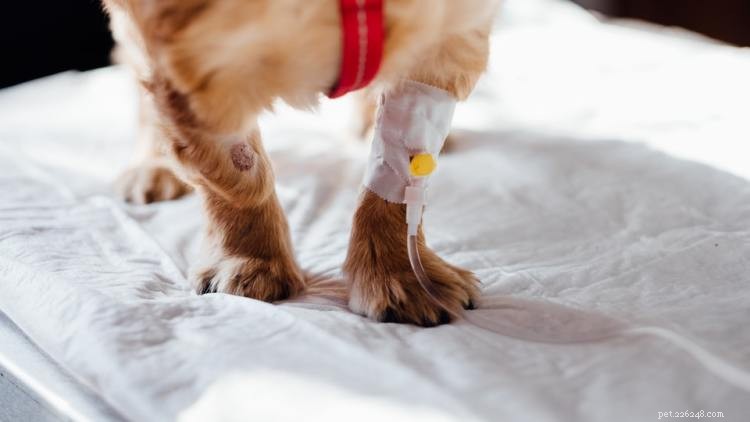リンパ腫は犬の癌の一種です。あなたのペットがリンパ腫にかかっている場合、その予後は、そのタイプ、どこにあるのか、どこまで広がっているのか、どの程度悪性度が高いのかによって異なります。この記事では、犬のリンパ腫の最も一般的な症状、診断、治療オプション、生存率などについて説明します.
以下のセクションでは、犬のリンパ腫について知っておくべきことをすべて取り上げます。
目次
上級者向けのヒント: 多くのペット保険プランは、リンパ腫の犬を含むさまざまな種類のがんをカバーしています。ペットの健康保険に加入することで、最悪の事態が発生した場合に犬の生活の質を維持するための最善の治療を受けることができます。
リンパ腫(リンパ肉腫としても知られています) ) は、最も一般的な犬のがんの 1 つです。 、すべての犬の癌の 7% から 24% を占めます。これは、血液や組織を循環する免疫系の細胞であるリンパ球から発生します。このため、リンパ腫は、単一の種類のがんではなく、30 を超える既知のバリエーションを持つ全身性疾患と見なされています。
リンパ肉腫はあらゆる臓器に発生する可能性がありますが、通常はリンパ節などの免疫系の一部で発生します 、肝臓、骨髄、および脾臓。リンパ腫の犬の 50% 以上で、病気はリンパ節に存在します。あまり一般的ではありませんが、腸、皮膚、胸腔、その他の臓器に発生します。
高齢および中年の子犬は、リンパ腫を発症する可能性が高くなります。 10 歳以上の犬の 50% 近くががんを発症しますが、遺伝的に素因のある犬種の中には、より高いリスクにさらされるものもあります。リストには以下が含まれます:
犬のリンパ腫は、最も研究が進んでおり、最もよく理解されているタイプの犬の癌の 1 つで、人間の非ホジキン リンパ腫と非常によく似ています。 .この類似性により、人間の医師と獣医はほぼ同じ治療プロトコルを使用します。
残念ながら、犬のリンパ腫は治せません しかし、寛解期間が長い数少ない犬の癌の 1 つです。適切な治療を受ければ、多くのペットは診断後しばらくの間、通常の生活の質を享受できます。
 (画像ソース:[Pexels]((画像ソース:Pexels)
(画像ソース:[Pexels]((画像ソース:Pexels)
犬のリンパ腫の原因はわかっていません .犬は私たちの環境を共有しているため、科学者は原因が多因子である可能性があると考えています. This means that they’re exposed to the same cancer-causing factors, including toxic substances like pesticides, insecticides, herbicides paints, solvents; exposure to electromagnetic fields or radiation; the influence of bacteria, viruses, and immunosuppression.
There are over 30 known types of canine lymphomas , all of which vary in symptoms, aggressiveness, and survival rates. Here are the most common types of canine lymphoma that dog owners should be aware of:
Multicentric cancer is the most common type of canine lymphoma, accounting for up to 85% of all cases . It primarily affects the lymph nodes, and swollen lymph nodes are usually the first clinical symptom. If your dog displays swelling, don't panic immediately, as it could also be in response to inflammation or infection. However, you should schedule an appointment with your veterinarian to discuss your concerns as soon as possible.
Alimentary lymphoma is the second most common form of lymphoma in dogs, accounting for less than 10% of akk cases. This form of the disease targets the intestines, causing gastrointestinal lesions which result in diarrhea, vomiting, and weight loss.
This cancer targets a specific organ in the body, such as the central nervous system, lungs, skin, kidneys, and eyes. One of the most common types of extranodal lymphoma is cutaneous lymphoma, which affects the skin.
Mediastinal lymphoma is a rare form of the disease. It usually causes the thymus or mediastinal lymph nodes in the chest to become enlarged.
The clinical signs will vary depending on the type of canine lymphoma and the organ(s) it affects . However, the most common symptoms of dogs with lymphoma include:
In canines with multicentric lymphoma , the most obvious symptom are enlarged lymph nodes. The swellings feel like firm lumps that move freely under the skin and are not painful. Pets with this type of lymphoma might also develop fever, lethargy, weakness, dehydration, and anorexia.
Animals with alimentary lymphoma might experience vomiting, diarrhea, weight loss, abdominal pain, and anorexia.
The symptoms of extranodal lymphoma will depend on which organ is affected. The most common type, cutaneous lymphoma , primarily involves the skin and can appear in a variety of lesions. The lesions can be plaques, ulcers, reddish patches, areas of hair loss and scaling, and lumps. Noticeable lesions can also appear in the lips, gums, or roof of your pup’s mouth, which may be itchy. If your dog develops this type of canine lymphoma, you might also notice raised nodules.
When the cancer affects other parts of the body, extradonal lymphoma symptoms in dogs might appear involve:
The clinical signs of canine mediastinal lymphoma include excessive thirst, increased urination, and swelling in the face or legs due to elevated calcium levels in the blood. Most commonly, dogs experience difficulty breathing due to excess fluid building up in the chest cavity (known as pleural effusion ), or the lymphoma itself compressing the lungs.
Veterinarians usually diagnose canine lymphoma with a biopsy , or the extraction of a sample cancer cell for microscopic analysis. They might order bloodwork and additional lab tests,** such as a urinalysis, to check if the organs are functioning properly.
Some vets also recommend “staging tests” to determine how far the lymphoma has progressed throughout the body. These tests help vets understand the animal’s overall condition and identify potential health issues that might affect the cancer treatment and prognosis. Staging tests can include x-rays of the abdomen and chest, abdominal sonograms, as well as bone marrow aspiration.
The staging of lymphoma is very complicated, but in general, it follows something similar to the outline below:
There are five stages of canine lymphoma:
Stage l: A single lymph node is affected.
Stage ll: Multiple lymph nodes are affected, but only on one side of the diaphragm.
Stage lll :Multiple lymph nodes are affected on both sides of the diaphragm.
Stage lV: The spleen and/or liver become affected.
Stage V: The bone marrow, central nervous system, or other extranodal sites become affected.
Stages lll-V are more common, whereas we rarely catch and diagnose dogs in stages I and II.
If your dog is diagnosed with lymphoma, they may need to see a veterinary oncologist . The oncologist will recommend suitable treatment based on the cancer’s stage and aggressiveness. The most commonly used treatment is chemotherapy but in some cases, a combination of treatments may be recommended.
Chemotherapeutic drugs are usually given by IV (intravenous) injection in order to destroy cancer cells and stop them from multiplying. Some chemotherapy treatments may also be given orally, in the form of tablets and capsules.
Most dogs tolerate chemotherapy well , but about 20% of them will experience some of the side effects that humans experience, including vomiting, nausea, diarrhea, decreased activity, and loss of appetite. Unlike humans, dogs usually don’t experience hair loss when treated with chemotherapy. The exceptions to this rule are Old English Sheepdogs, Poodles, and some Terrier breeds. Hair growth usually resumes once chemotherapy is discontinued.
Even though some pets do get sick from chemotherapy, more serious side effects are not common. If more severe side effects occur, talk to your oncology doctor or staff. They will recommend symptomatic treatment to ease these side effects or decide to reduce the dose next time chemotherapy is given.
In some cases, dogs can enter remission following chemotherapy. However, most pups suffering from this disease will have a relapse sooner or later. A second remission can be achieved in a large number of canine patients, but it is usually shorter in duration than the first one. This is due to the fact that the lymphoma cells become more resistant to the effects of chemotherapy over time.
Radiation therapy uses high-energy gamma rays to destroy cancer cells in the area affected by lymphoma. This type of therapy is painless, but the dog might experience skin irritation in the targeted area after treatment. In that case, an antipruritic may be prescribed, or the dog might be given a cone to wear to prevent them from scratching.
If the cancer is still localized, affected lymph nodes or other tumors might be surgically removed.
The cost of canine lymphoma treatment can be quite high, possibly more than $10,000 , especially if owners choose to explore all available treatment options. The diagnosis and treatment expenses will depend on several factors, including geographic location, the standard of care, and whether specialty hospitals are employed.
上級者向けのヒント: When people wonder whether pet insurance is worth the cost, expenses like these demonstrate its value. Plans covers illnesses such as cancer, as well as the medication required to maintain good quality of life. However, you won't be able to receive pet insurance for pre-existing conditions, so it's important to enroll your dog early, prior to the development of health issues later in life.

(Image source:Pexels)
The prognosis will depend on the type of lymphoma your dog has, the cancer stage at the time of treatment, and the selected treatment .
In general, the more places the wider the lymphoma has spread, the poorer the prognosis. However, pets with very advanced lymphoma can still be treated and experience remission.
Pets in remission usually still have cancer but it has become undetectable to any available screening test. Treatment can extend your pet’s life, but it rarely cures the disease completely and most lymphoma patients will have a relapse sooner or later.
Unfortunately, lymphoma is almost always fatal. However, there are certain steps pet parents can take to help their dogs after diagnosis. Your veterinarian will explain the available treatment options and what to expect as the disease progresses.
If your pet has many uncomfortable symptoms associated with lymphoma, such as vomiting, diarrhea, and lack of energy, and if the cancer has also become painful, you might want to consider euthanasia . Euthanasia is a peaceful and painless way to end your loved one's suffering. The process is similar to general anesthesia and takes no more than a few minutes. Your veterinarian can help you decide when the time is right to euthanize your dog.
If you decide not to put your dog to sleep, your vet will explain how to make your dog’s final days or weeks more comfortable with the proper use of pain medications, dietary choices, and human interaction.

あなたの犬はいつもよりも頻繁につまずいたり、よろめいたり、転んだりしていますか?もしそうなら、バランスの喪失は、運動失調として知られる病状が原因である可能性があります.運動失調は、協調運動の喪失をもたらす感覚機能障害に関連する状態です。これは深刻な健康問題であり、直ちに獣医の診察が必要です。 犬の運動失調症の症状が発生した場合に、その症状をよりよく認識できるように、この状態についてさらに学習するために読み続けてください. 目次: 運動失調とは? 犬の運動失調の原因 犬の運動失調の症状 犬の運動失調の診断 犬の運動失調の治療 重要ポイント プロのヒント: 入会時に症状がなければ、犬の

犬の大腸炎は痛みを伴う不快な状態であり、愛犬が下痢や胃の不調を引き起こす可能性があります.ありがたいことに、適切な治療を行えば、大腸炎はすぐに治ります。 犬の大腸炎の症状、大腸炎と単純な胃の不調を区別する方法、利用可能な治療オプションについて詳しく知るために読んでください. 目次: 犬の大腸炎とは? 症状は何ですか? どのくらい持続しますか? 犬の大腸炎の原因は? 伝染性ですか? 犬の大腸炎はどのように診断しますか? 犬の大腸炎はどのように治療しますか? 治療費はいくらですか? 予後と回復は? 予防可能ですか? プロのヒント: 獣医への旅行は、経済的援助がなければ高価になる可能性